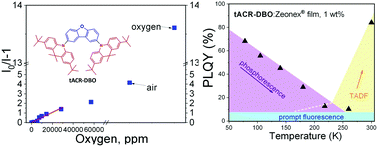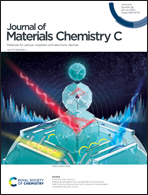Oxygen sensing and OLED applications of di-tert-butyl-dimethylacridinyl disubstituted oxygafluorene exhibiting long-lived deep-blue delayed fluorescence†
Abstract
Efficient deep-blue thermally activated delayed fluorescence with emission maximum at 425 nm and a photoluminescence quantum yield of 84% were observed for the synthesised di-tert-butyl-dimethylacridinyl disubstituted oxygafluorene dispersed under a nitrogen atmosphere in an inert polymer. Its TADF intensity decreased by 14 times when the sample was placed under an oxygen environment showing its potential for optical sensing of oxygen. The optical sensor demonstrated oxygen sensitivity of up to ca. 30 000 ppm with a Stern–Volmer constant KSV of 5.26 × 10−5 ppm−1. Electroluminescence spectrum with a peak wavelength at 446 nm and full width at half maximum of 62 nm was observed using the compound as a thermally activated delay fluorescence emitter in organic light-emitting diodes. Maximum external efficiency of the deep-blue device with CIEy of 0.08 reached 9.9%.



 Please wait while we load your content...
Please wait while we load your content...